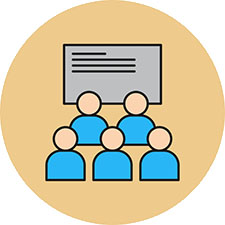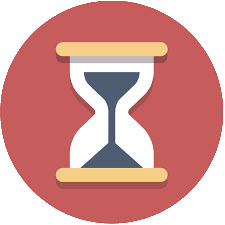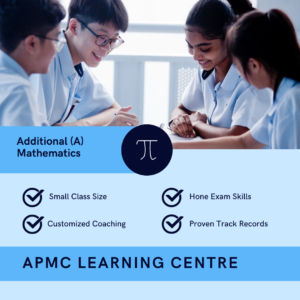Primary School Math Tuition | PSLE Math Tuition
APMC’s Primary School Math Tuition is meticulously crafted to prepare students to achieve PSLE success starting from Primary 3 where layers of the foundation are constantly laid and materialized through our proven methods of revision. By Primary 6, our students will have the necessary skills, aptitude, and confidence to embrace PSLE Mathematics. To help our students revise effectively, we provide comprehensive notes, concept maps, and regular practice papers. Our curriculum materials are constantly kept abreast with prevailing PSLE trends to ensure that students are ready for the more current questions types
With a small class size of 6 (max 8), we ensure that every student receives our dedicated attention during our classes. Quizzes, games, and real-world projects make the learning of Mathematics interactive, fun, and real for our students. We champion consistency and active learning in students, equipping them with the skills and wits to carve out their edge in Mathematics / Math and eventually ACE the PSLE examination.
To prepare students for PSLE success and beyond, our students will be exposed to topical revision through comprehensive concept maps and noteworthy past examination questions during our Primary School Math Tuition. Students will further solidify their examination skills through error analysis exercises and practice tests.
Primary School Math Tuition Curriculum
Primary 3
Whole Numbers up to 10 000
|
Addition and Subtraction
|
Multiplication and Division
|
Money
|
Fractions
|
Length
|
Mass
|
Volume
|
Time
|
Bar Graphs
|
Geometry
|
Area and Perimeter
|
Primary 4
Whole Numbers up to 100 000
|
Fractions
|
Decimals
|
Area and Perimeter
|
Patterns
|
Geometry
|
Symmetry
|
Tables and Graphs
|
Average*
|
Number Sequences*
|
Tessellations*
|
Note: * denotes GEP components
Primary 5
Whole Numbers up to 10 000 000
|
Fractions
|
Area of Triangles
|
Ratio
|
Measurements
|
Decimals
|
Area and Perimeter
|
Average
|
Volume and Surface Area
|
Rates
|
Percentage
|
Geometry
|
Tables and Graphs
|
Number Patterns
|
Solid Figures*
|
Investigative Problem Solving*
|
Note: * denotes GEP components
Primary 6
Algebra• Simplifying algebraic expressions |
Speed
|
Circles
|
Area and Perimeter
|
Solid Figures
|
Pie Charts
|
Rates
|
Whole Numbers (Revision)
|
Fractions (Revision)
|
Decimals (Revision)
|
Percentage (Revision)
|
Ratio (Revision)
|
Average (Revision)
|
Number Patterns (Revision)
|
Geometry (Revision)
|
Volume and Surface Area (Revision)
|
Note: * denotes GEP components
Primary School Math Tuition Highlights
Content Mastery
- In Primary 3, students will master new topics including area and perimeter, angles, parallel and perpendicular lines and bar graphs. Students will also hone their problem-solving skills by applying heuristics including advanced model drawing, making a supposition and forming equations. In addition, they will learn to use specific tools, including the set-square and a ruler to draw parallel and perpendicular lines.
- In Primary 4, students will master new topics such as decimals and symmetry. Students will also hone their problem-solving skills by applying heuristics including advanced model drawing, branching and unitary method. In addition, they will learn to use specific tools to measure and construct angles.
- In Primary 5, students will learn new concepts in topics such as area of triangles, ratio, volume, rates, average and percentage. Additionally, they will learn and apply heuristics such as making a table, working backwards, forming equations, branching and unitary method to solve problems effectively. Students will also use calculators to solve word problems in Paper 2. They will hone examination skills such as error analysis and time management through practice tests.
- In Primary 6, students will complete the PSLE syllabus including learning new topics such as algebra, circles, speed and pie charts. Students will master key heuristics such as unitary method, units and parts and comparing difference to solve questions more efficiently.
Skills and Techniques
- Students will be trained to apply various heuristics to solve complex word problems involving multiple topics/concepts and tackle non-routine problems
- Students will learn techniques for checking answers, such as checking for reasonableness and working backwards
- Students will analyze and reflect on how to apply the most efficient techniques for exams and to avoid errors
- Students will be trained on other examination skills such as proper time management, effective stress management techniques and presenting solutions neatly
- Students will explore and hone their logical reasoning skills through puzzles
- Students will reinforce new concepts learnt through card games and online games
Revision and Reinforcement
- Towards Mid or PSLE Exam, APM’s Math Tuition focuses on revising and mastering all the topics through practice tests and revision handouts, which include questions that test foundational knowledge and examination questions
- Hone key examination skills such as time management and error analysis with practices on specific question types
Key Features of Our Primary School Math Tuition Classes

Small Class Size
2 to 8 students
Conducive Learning Environment

Customized Coaching
Reinforcing current school topics
1 to 1 Coaching

Hones Exam Skills
Time Management Skills
Exam Questions Training

Proven Track Records
> 86% Scoring A
> 93% improvement

Lesson Duration
2 Hrs Weekly (Sec & JC)
1.5 Hrs Weekly (Pri)
KJ said he wants to tell you his new score.
He got 95!
Please pretend don’t know. We are happy for him!
Primary 5 Math, Evergreen Primary School
Explore Other Subjects

Primary School

Secondary School





